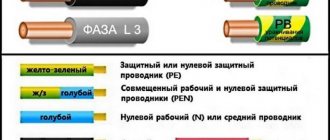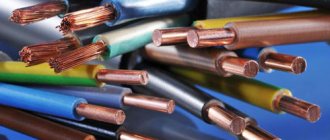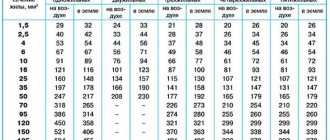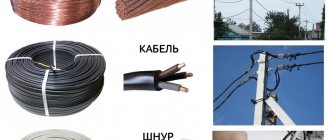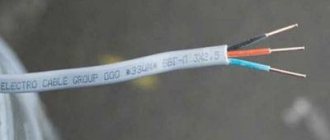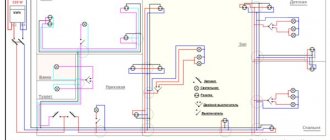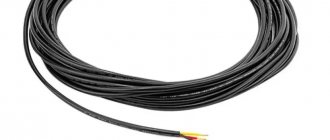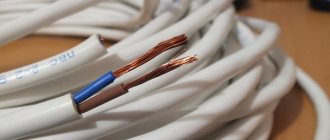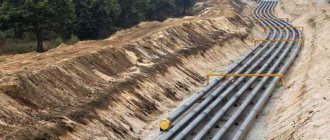The power and current cable cross-section calculator will help you calculate the minimum cable cross-section required for safe operation of electrical wiring to avoid overheating, insulation melting, short circuits and fires.
The calculator allows you to calculate the cable cross-section by current or power, based on the parameters of the total load and incoming voltage. This takes into account the installation conditions, wire manufacturing materials, possible voltage losses and conductor selection criteria. The functionality of the section also allows you to calculate the maximum current and load on a conductor with specified parameters and select protection devices (circuit breakers, differential circuit breakers and RCDs).
How to calculate the cable cross-section:
- Indicate the source data (current or power), voltage, conductor material (copper or aluminum), type of wiring (open or closed in a pipe), number of wires (when laying communications in a pipe);
- Note additional conditions (wire length, permissible losses);
- Click on the “Calculate” button and save the resulting parameters.
The cable cross-section calculator works online and offline. Please note: it is for guidance only and cannot guarantee 100% accuracy of the calculations. However, the more valid data you enter into the appropriate fields, the higher the match rate will be.
Related regulatory documents:
- PUE-7 “Rules for electrical installations”
- SP 76.13330.2016 “Electrical devices”
- GOST R 50571.5.52-2011/IEC 60364-5-52:2009 “Low-voltage electrical installations. Selection and installation of electrical equipment"
- GOST 31946-2012 “Self-supporting insulated and protected wires for overhead power lines”
- GOST 31947-2012 “Wires and cables for electrical installations for rated voltage up to 450/750 V”
- GOST 6323-79 “Wires with polyvinyl chloride insulation for electrical installations”
- GOST 31996-2012 “Power cables with plastic insulation for a rated voltage of 0.66; 1 and 3 kV"
- GOST 433-73 “Power cables with rubber insulation”
How to calculate cable cross-section by power: formula
Before choosing a cable cross-section based on power, you need to calculate its total value and make a list of electrical appliances located in the territory to which the cable is laid. The power must be indicated on each device; the corresponding units of measurement will be written next to it: W or kW (1 kW = 1000 W). Then you will need to add up the power of all equipment and get the total.
1️⃣ First step. The total power of all electrical appliances that can be connected to the network is calculated:
Psum = (P1 + P2 + .. + Pn) × Kс
- P1, P2 .. – power of electrical appliances, W;
- Kc – demand coefficient (probability of simultaneous operation of all devices), default is 1.
2️⃣ Second step. Then the rated current in the circuit is determined:
I = Psum / (U × cos ϕ)
- Psum – total power of electrical appliances;
- U – network voltage;
- cos ϕ – power factor (characterizes power losses), default is 0.92.
3️⃣ Third step. At the last stage, tables are used in accordance with the PUE (Electrical Installation Rules).
Table of copper cable cross-section by current according to PUE-7
| Conductor cross-section, mm2 | Current, A, for wires laid | |||||
| open | in one pipe | |||||
| two single-core | three single-core | four single-core | one two-wire | one three-wire | ||
| 0.5 | 11 | – | – | – | – | – |
| 0.75 | 15 | – | – | – | – | – |
| 1 | 17 | 16 | 15 | 14 | 15 | 14 |
| 1.2 | 20 | 18 | 16 | 15 | 16 | 14.5 |
| 1.5 | 23 | 19 | 17 | 16 | 18 | 15 |
| 2 | 26 | 24 | 22 | 20 | 23 | 19 |
| 2.5 | 30 | 27 | 25 | 25 | 25 | 21 |
| 3 | 34 | 32 | 28 | 26 | 28 | 24 |
| 4 | 41 | 38 | 35 | 30 | 32 | 27 |
| 5 | 46 | 42 | 39 | 34 | 37 | 31 |
| 6 | 50 | 46 | 42 | 40 | 40 | 34 |
| 8 | 62 | 54 | 51 | 46 | 48 | 43 |
| 10 | 80 | 70 | 60 | 50 | 55 | 50 |
| 16 | 100 | 85 | 80 | 75 | 80 | 70 |
| 25 | 140 | 115 | 100 | 90 | 100 | 85 |
| 35 | 170 | 135 | 125 | 115 | 125 | 100 |
| 50 | 215 | 185 | 170 | 150 | 160 | 135 |
| 70 | 270 | 225 | 210 | 185 | 195 | 175 |
| 95 | 330 | 275 | 255 | 225 | 245 | 215 |
| 120 | 385 | 315 | 290 | 260 | 295 | 250 |
| 150 | 440 | 360 | 330 | – | – | – |
| 185 | 510 | – | – | – | – | – |
| 240 | 605 | – | – | – | – | – |
| 300 | 695 | – | – | – | – | – |
| 400 | 830 | – | – | – | – | – |
Table of cross-section of aluminum cable by current according to PUE-7
| Conductor cross-section, mm2 | Current, A, for wires laid | |||||
| open | in one pipe | |||||
| two single-core | three single-core | four single-core | one two-wire | one three-wire | ||
| 2 | 21 | 19 | 18 | 15 | 17 | 14 |
| 2.5 | 24 | 20 | 19 | 19 | 19 | 16 |
| 3 | 27 | 24 | 22 | 21 | 22 | 18 |
| 4 | 32 | 28 | 28 | 23 | 25 | 21 |
| 5 | 36 | 32 | 30 | 27 | 28 | 24 |
| 6 | 39 | 36 | 32 | 30 | 31 | 26 |
| 8 | 46 | 43 | 40 | 37 | 38 | 32 |
| 10 | 60 | 50 | 47 | 39 | 42 | 38 |
| 16 | 75 | 60 | 60 | 55 | 60 | 55 |
| 25 | 105 | 85 | 80 | 70 | 75 | 65 |
| 35 | 130 | 100 | 95 | 85 | 95 | 75 |
| 50 | 165 | 140 | 130 | 120 | 125 | 105 |
| 70 | 210 | 175 | 165 | 140 | 150 | 135 |
| 95 | 255 | 215 | 200 | 175 | 190 | 165 |
| 120 | 295 | 245 | 220 | 200 | 230 | 190 |
| 150 | 340 | 275 | 255 | – | – | – |
| 185 | 390 | – | – | – | – | – |
| 240 | 465 | – | – | – | – | – |
| 300 | 535 | – | – | – | – | – |
| 400 | 645 | – | – | – | – | – |
In the Electrical Installation Rules, 7th edition, there are no tables of cable cross-section by power, there is only data on current strength. Therefore, when calculating sections using load tables on the Internet, you risk getting incorrect results.
Selecting cable cross-section based on current strength: calculation formula
The amount of current passing through a conductor depends on the length, width, resistivity of the latter and on temperature. When heated, the electric current decreases.
1️⃣ First step. The calculation is carried out in exactly the same way, that is, first the total power of all electrical appliances that can be connected to the network is calculated:
Psum = (P1 + P2 + .. + Pn) × Kс
- P1, P2 .. – power of electrical appliances, W;
- Kc – demand coefficient (probability of simultaneous operation of all devices), default is 1.
2️⃣ Second step. Then the rated current in the circuit is determined:
I = Psum / (U × cos ϕ)
- Psum – total power of electrical appliances;
- U – network voltage;
- cos ϕ – power factor (characterizes power losses), default is 0.92.
3️⃣ Third step. At the last stage, the same tables are used, according to the PUE (Electrical Installation Rules), which are located above.
What brand of cable is best to use to connect the motor?
When selecting cable brands for powering asynchronous electric motors, take into account the conditions in which they will operate. To provide power to mobile electrical installations that often move between construction sites or other work, preference should be given to flexible brands of cable products. There are a number of mechanisms driven by asynchronous electric motors, which make constant movements during operation. For example, beam cranes, electric hoists and other lifting equipment. The electric drive of such mechanisms is connected to the electrical network only with flexible copper cables with rubber insulation. The current cores of flexible cables are assembled with bundles of thin copper wire, so they can withstand repeated bending.
The most suitable and popular brands for such engines are KPGS, KPG1U
healthy:
Detailed information and review of brands suitable for connecting a crane beam in our article “Cable for a crane beam”
For installation in the ground, it is advisable to choose an armored cable (for example, VBShv or AVBShv) to exclude the possibility of accidental damage in hard ground. It is allowed to lay PVC-sheathed cables in trenches with a sand cushion. These types of cables can also be laid in trays.
healthy:
Useful information about armored cables and recommendations for installation in the article “Cable for laying in the ground”
Calculation of cable cross-section by length: formula
The cable length affects the voltage loss. Thus, the voltage at the end of the conductor may decrease and be insufficient to operate the electrical appliance. For household electrical networks, these losses can be neglected. It will be enough to take a cable 10-15 cm longer. This reserve will be used for switching and connection. If the ends of the wire are connected to the shield, then the spare length should be even greater, since circuit breakers will be connected.
1️⃣ First step. First, the rated current in the circuit is determined:
I = Psum / (U × cos ϕ)
- Psum – total power of electrical appliances;
- U – network voltage;
- cos ϕ – power factor (characterizes power losses), default is 0.92.
2️⃣ Second step. Then the conductor resistance is calculated:
R = dU/I
- dU – voltage loss, no more than 5% (0.05);
- I – current strength.
3️⃣ Third step. The cross-section of the current-carrying conductor is calculated using the formula:
S = ρ × L/R
- ρ – metal resistivity, copper (0.0175), aluminum (0.028);
- L – conductor length;
- R – conductor resistance.
Software for tablet and mobile phone
If a more convenient option for you would be to use programs for calculating the cross-section of a wire or cable on a mobile device, then we are ready to offer you the following options:
- Mobile electrician;
- CuCalc;
- SCT Electro;
- SafetyCalc;
- "Electrical calculations".
The principle of operation of programs for mobile phones is approximately the same as that of their computer “brothers”: we enter the necessary data and calculate the indicators. Also, all of the applications described above are easy to use and have a user-friendly interface, however, if you don’t have time to study them, you can always watch video tutorials. They will help you quickly understand the services and start working with them immediately.
The convenience of mobile applications is that they are always at hand, and you can perform the calculation immediately before purchasing conductors.
These applications can be found on Google Play and downloaded completely free of charge. Using them, you can quickly and accurately calculate the wire cross-section for the load, taking into account the type of electrical network or the length of the cable line.
How to choose cable sections?
There are several more criteria that the cross-section of the wires used must meet:
- Length of cable
. The longer the wire, the greater the current loss observed in it. This again occurs as a result of an increase in resistance, which increases as the length of the conductor increases. This is especially noticeable when using aluminum wiring. When using copper wires to organize electrical wiring in an apartment, the length, as a rule, is not taken into account - the standard margin of 20–30% (for hidden wiring) is more than enough to compensate for possible increases in resistance associated with the length of the wire. - Type of wires used
. There are 2 types of conductors used in household electricity supply - copper or aluminum based. Copper wires are of better quality and have less resistance, but aluminum wires are cheaper. In full compliance with the standards, aluminum wiring copes with its tasks no worse than copper, so you need to carefully weigh your choice before purchasing a wire. - Electrical panel configuration
. If all the wires supplying consumers are connected to one circuit breaker, then it will be the weak point in the system. A heavy load will lead to heating of the terminal blocks, and non-compliance with the rating will lead to its constant operation. It is recommended to divide the electrical wiring into several “beams” with the installation of a separate machine.
In order to determine the exact data for choosing the cross-section of electrical wiring cables, it is necessary to take into account any, even the most insignificant parameters, such as:
- Type and type of insulation of electrical wiring;
- Length of sections;
- Laying methods and options;
- Features of temperature conditions;
- Humidity level and percentage;
- The maximum possible value of superheat;
- The difference in the powers of all current receivers belonging to the same group. All these and many other indicators can significantly increase the efficiency and benefits of energy use on any scale. In addition, correct calculations will help avoid cases of overheating or rapid abrasion of the insulating layer.
In order to correctly determine the optimal cable cross-section for any human household needs, it is necessary in all general cases to use the standardized following rules:
- for all sockets that will be installed in the apartment, it is necessary to use wires with an appropriate cross-section of 3.5 mm²;
- for all spotlighting elements, it is necessary to use electrical wiring cables with a cross-section of 1.5 mm²;
- As for high-power devices, cables with a cross-section of 4-6 mm² should be used.
If some doubts arise during the installation or calculation process, it is better not to act blindly. The ideal option would be to refer to the appropriate table of calculations and standards.
Table: Cable cross-section for closed and open wiring
Video: How to choose a wire cross-section?
Wire installation
The technology for installing SIP wires does not present any particular difficulties. Thanks to this, with the proper skill and free time, you can complete all the work yourself. But in order to install the SIP cable yourself, you must first coordinate the work with government services. In addition, before you begin installing the SIP wire to the house, you need to obtain permission from the company supplying electricity. In order to correctly carry out all work on connecting the line, you need to carefully study the recommendations of specialists. The step-by-step instructions for installing SIP wires say: 1. First of all, you need to select a product of the required cross-section. Most often, for installing SIP cables from a pole to a house, products with a cross-section of 15 mm are used. 2. If the extension line exceeds 25 m, you will need to install additional support and use a tensioner.
3. In the case when it is necessary to branch the SIP cable line, additional components will be needed for installation - a special clamp. With its help, you can make punctures on the pole in the right places. The advantages of using clamps include simplified installation - you will not need to strip the cable. Next, the installation of the SIP cable from the pole to the building is carried out according to the following plan: 1. Attach special fasteners to the support. Fasteners are necessary to ensure a strong connection. 2. Install the clamp. To do this, among the components for installing SIP wires there must be an anchor-type clamping device. It is a fitting with a bracket. 3. If wood was used for the construction of the building, according to the rules for installing SIP cables, additional insulation of the wire must be performed. To carry out wiring to stone or brick houses, there is no need to additionally insulate the wire. 4. Lead the wire 1 m into the building. 5. Make a branch inside the house. To correctly install SIP wires inside a building, you can watch a video. If necessary, a special coupling may be required to connect the cables.
Open and closed wiring
Depending on the placement, wiring is divided into 2 main types: closed and open.
Today, hidden wiring is installed in apartments. Special recesses are created in the walls and ceilings to accommodate cables. After installing the conductors, the recesses are plastered. Copper wires are used. Everything is planned in advance, because over time, to build up electrical wiring or replace elements, you will have to dismantle the finishing. For hidden finishing, wires and cables that have a flat shape are often used.
When laid open, the wires are installed along the surface of the room. Advantages are given to flexible conductors that have a round shape. They are easy to install in cable channels and pass through the corrugation. When calculating the load on the cable, the method of laying the wiring is taken into account.
Wire installation
The technology for installing SIP wires does not present any particular difficulties. Thanks to this, with the proper skill and free time, you can complete all the work yourself. But in order to install the SIP cable yourself, you must first coordinate the work with government services. In addition, before you begin installing the SIP wire to the house, you need to obtain permission from the company supplying electricity. In order to correctly carry out all the work on connecting the line, you need to carefully study the recommendations of specialists. The step-by-step instructions for installing SIP wires say: 1. First of all, you need to select a product of the required cross-section. Most often, for installing SIP cables from a pole to a house, products with a cross-section of 15 mm are used. 2. If the extension line exceeds 25 m, you will need to install additional support and use a tensioner.
3. In the case when it is necessary to branch the SIP cable line, additional components will be needed for installation - a special clamp. With its help, you can make punctures on the pole in the right places. The advantages of using clamps include simplified installation - you will not need to strip the cable. Next, installation of the SIP cable from the pole to the building is carried out according to the following plan: 1. Attach special fasteners to the support. Fasteners are necessary to ensure a strong connection. 2. Install the clamp. To do this, among the components for installing SIP wires there must be an anchor-type clamping device. It is a fitting with a bracket. 3. If wood was used for the construction of the building, according to the rules for installing SIP cables, additional insulation of the wire must be performed. To carry out wiring to stone or brick houses, there is no need to additionally insulate the wire. 4. Lead the wire 1 m into the building. 5. Make a branch inside the house. To correctly install SIP wires inside a building, you can watch a video. If necessary, a special coupling may be required to connect the cables.
